Welcome to another newsletter, which has had a bit more revision. It seems to have turned into a bit of a celebration of Godfrey Phillips as well, but that is just the way things turn out. However as I do not have the updated Godfrey Phillips reference book, perhaps you would like to check whethere there have been any changes since the information that I hereby present.
A hectic week, aren`t they all, but we made it again, and pretty much in time. So read on, for apart from the plethora of Phillips, we have a flight of fancy, a Presidential train driver, a bag of delights, two amazing twins, an early excursion, the power of a kiss, and a last minute substitution of Florenz Ziegfeld rather than Jon Pertwee.
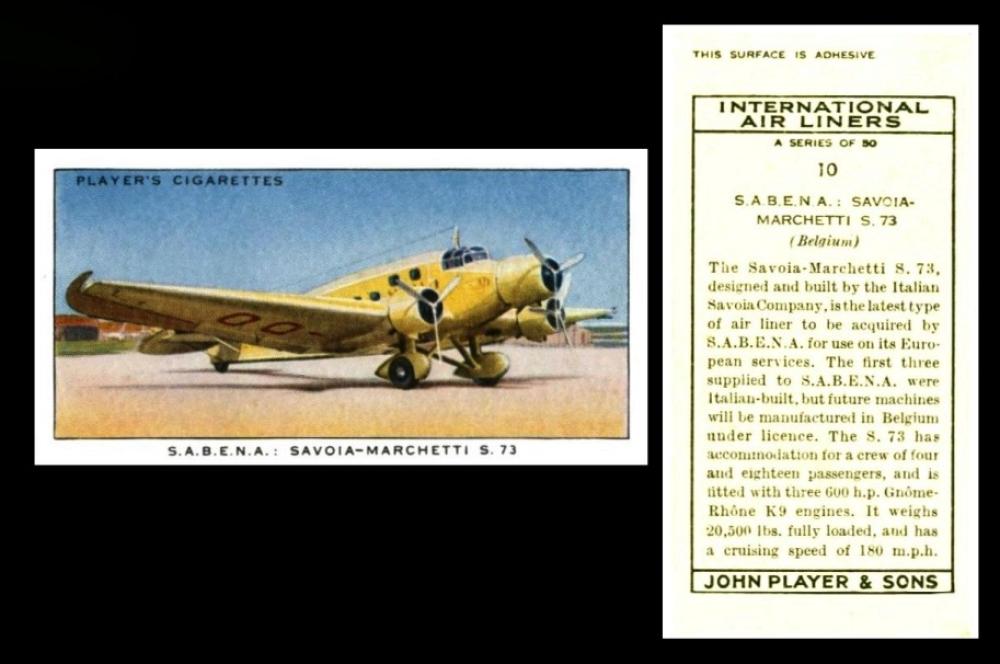
John Player [tobacco : UK] "International Air Liners" (November 1936) 10/50 - P644-672 : P72-220 : P/116.B (RB.17/116.B)
Now today in 1936 S.A.B.E.N.A. started a commercial service, from Brussels to London, stopping in Ostend. The initials stood for Societe Anonyme Belge de Exploitation de la Navigation Aerienne - in other words a Belgian Limited Company concerned with the operation of air travel . This it did, for it was the national airline of Belgium from 1923 to 2001. The company had only started on the 23rd of May 1923, but tellingly it had been created by the Belgian Government, in order to replace an earlier scheme which is usually said to have done much the same thing, but if you look at that name, and it was S.N.E.T.A, (Syndicat Nationale pour l`Etude des Transports Aeriens) then it seems not that it failed, but that it was only ever intended to be "l`etude", which means a study, or an investigation, into the subject. This makes it way more likely that the study closed, in 1919, the findings were thoroughly investigated, and then the actual "operation" commenced just a few years after.
In under a year from their first commercial flight they had added routes to the Netherlands, France and Switzerland. Then there was a pause before they expanded further into the Netherlands and Germany, during which they fulfilled their promise to some of their original backers and re-started an airline service in the Belgian Congo. They had a variety of aircraft for these longer and tougher flights, and in 1936 they had bought this aeroplane, the SM73, mainly because they were not too technical or fussy, and they also coped well with uneven ground.
This card is the scarcer Channel Islands issue, which only has one short line of text outside the framelines. In our original John Player reference book all the versions were listed together, which makes it easier to track them down. The description there is :
116. 50 International Air Liners. Small cards. Fronts in colour. Backs in grey, with descriptive text. Special album issued.
A) Home issue, adhesive backs, with Album clause ("price one penny") and I.T.C. Clause. Issued November 1936
B) Channel Islands issue, adhesive backs, no Album clause or I.T.C. Clause. Issued November 1936
C) Irish issue, adhesive backs, with Album clause (no price stated) and I.T.C. Clause. Issued July 1937
D) Overseas issue, non-adhesive backs. No Album or I.T.C. Clause. Anonymous issue. Issued May 1937
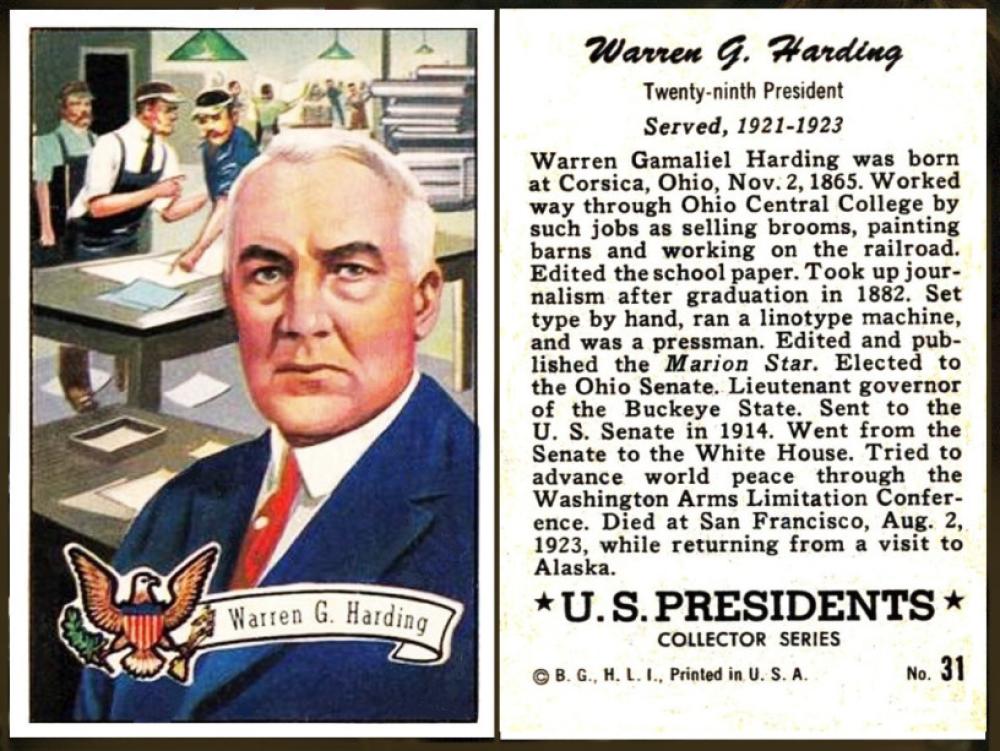
Bowman Gum [trade : confectionery : O/S ; U.S.A. ] "U.S. Presidents" (1952) 31/36
Now here we have Warren G. Harding, and look at that middle name of Gamaliel. This seems to speak of Jewish descent, as in the Bible there are several Gamaliels, most of them something to do with the law, or even Presidents of the Sanhedrin courts.
On this day though, he is reported to have done something very amazing, and that is to drive a railway locomotive, in Montana. However if you look at this card it says that he "worked his way through Ohio Central College by such jobs as ... working on the railroad". So he was no stranger to trains, and had perhaps even been allowed to do a spot of shunting, under supervision, or not.
This card is very interesting because it is almost identical to the set of U.S. Presidents issued by Topps Gum in 1956, including the eagle and curving banner on the front. It even looks like the numbers are the same, However the back of the Topps set is very much more colourful.
However Bowman, of Philadelphia, was a bubble gum manufacturer, and had been since the late 1920s. But in 1956 the company was bought by Topps, of New York City, and they ceased all mention of the Bowman name. That is until 1989, when they suddenly brought it back. But what seems to have happened is that in with the buyout was the artwork of these U.S, Presidents cards, and it was decided to re-issue them as Topps cards, with different backs so there could be no confusion.
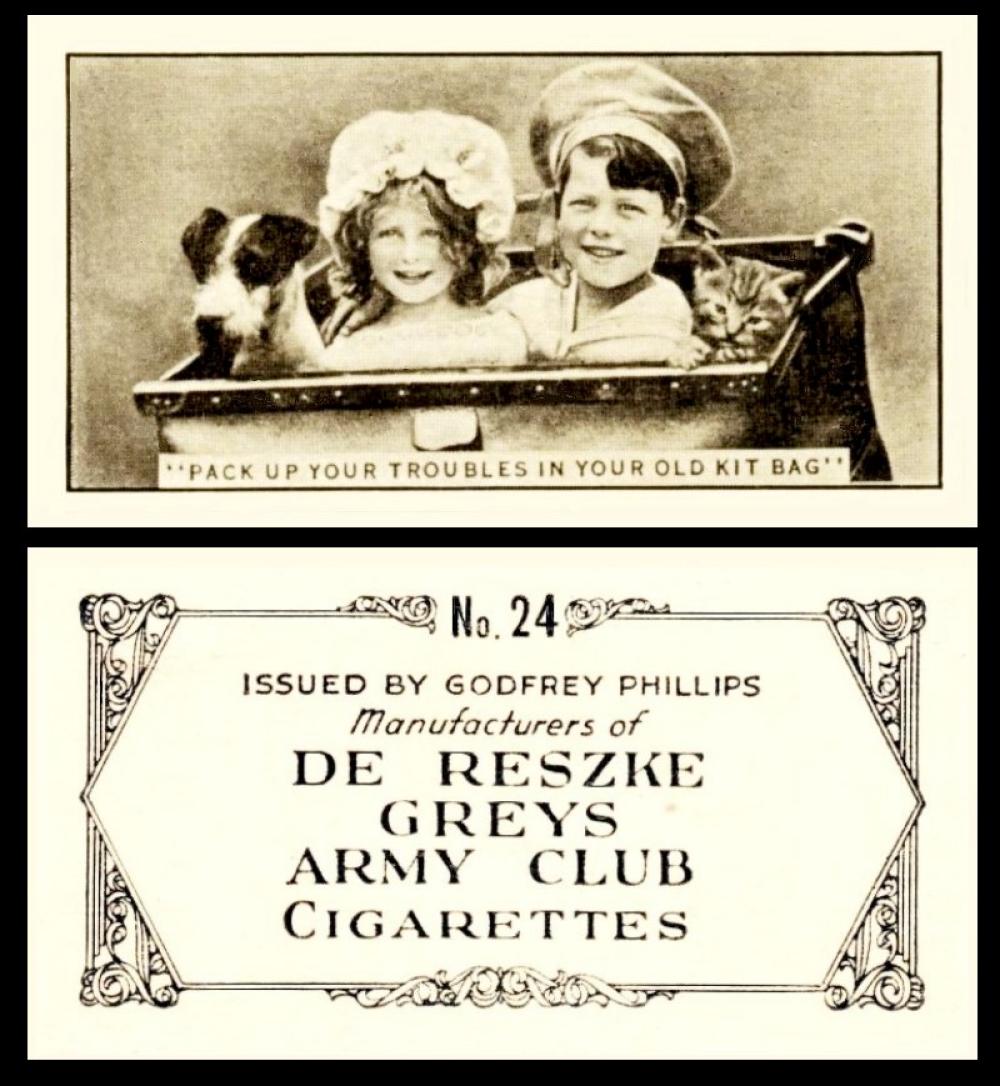
Godfrey Phillips [tobacco : UK] "Animal Studies" untitled (1933) 24/50 - P521-605 : P50-138 : Ph/7 (RB.13/7)
Today is Plastic Bag Free Day.
Over recent years the extraordinary waste and terrible disposal of the single use plastic bag has been curbed, thanks, in the most part, for charging for them, or by selling very attractive jute bags which are just as flexible. Waitrose has a great one at the moment for Pride Month, but some local councils do run regular promotions and give them away just for visiting your high street.
It is quite easy to make sure that you take your own bag, or box, and there are some super vintage and collectable bags and boxes which would turn heads at your local store should you use them.
However the main problem with plastic will always be not the usage, but the disposal.
This card comes from a set which gets a bit confusing, which is why the description is a bit late. In our original Godfrey Phillips reference book, RB.13, issued in 1949, it is listed below a set of 40 "Animal Series" - having fronts in colour and backs in blue - and above another set of 30, issued in 1936, and called "Animal Studies" - being medium cards fronts in colour and backs in black, but also embossed. Both those sets are titled, which made me wonder why this was chosen for our set - but wait, for the description of our set is :
7. 50 Animal Studies (adopted title). Small cards, size 67 x 35 m/m. Fronts printed by letterpress in sepia, glazed. Backs per Fig.16 in black. Subjects seen are similar to cards by Millhoff ("Real Photographs") and Cavander "Animal Studies", Issued ?1933 in Australia.
This explains why the title was chosen, but perhaps copying the Millhoff title would have been less confusing.
Anyway if anyone has either the Cavanders or the Millhoff and this card is there, do let us know.
Now armed with this info, I have found it in the World Tobacco Issues Index, under "section 5.E, AUSTRALIAN ISSUES, 1932-34. Inscribed "Godfrey Phillips(Aust) Pty. Ltd. Melbourne" and small size 63 x 36 m/m, unless stated. All fronts glazed except Set P50-143 [which is "Victorian Footballers"]." It continues with
ANIMAL STUDIES (A). Sm. 66 x 35. Sepia. Nd. (50). See Ha.538. Inscribed "Issued by Godfrey Phillips - Manufacturers of De Reszke, Greys, Army Club Cigarettes"
And this is the same as appears in our updated version, except that the code is new.
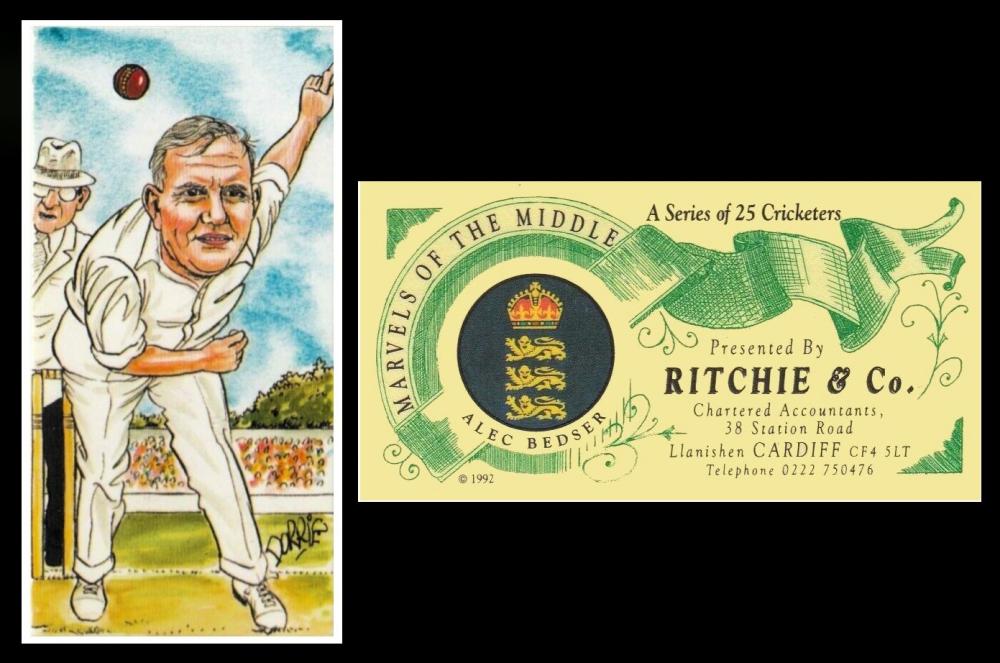
Ritchie & Co. [trade : accountancy services : UK] "Marvels of the Middle" (1992) Un/25 -
Today, in 1918, this man, Alec Victor Bedser, was born in Reading, along with his identical twin, and fellow cricket champion, Eric Arthur. Both loved bowling best, but early on they did not want to be identical at everything so a simple, but fateful, toss of a coin saw Alec agree to be the best ever at bowling and Eric at batting.
They were inseparable, serving in France for the Royal Air Force and both refusing to leave the beaches of Dunkirk without the other. In fact Alec refused promotion so that the two could serve together. And neither got married, they lived together, until Eric died, in a house they had built with their father`s advice and assistance, for he was a bricklayer.
Now I wish even more that I had been able to find a card of them together on the one card. There must be one somewhere, and I will keep hunting.
This card was issued by a Chartered Accountants, based in Cardiff. And we have been able to fill in quite a few gaps, thanks to our readers. The first thing we were unsure of was the address, On these cards it was 38 Station Road in Llanishen but when we did some research we found that they had moved on, and at this address since 2019 had been the Honeybee House Tearooms. And before that, it was also a tearooms, under the same management, but called the Selah Cafe & Tearooms.
Now we also discovered a bit more about them in the January 1995 "Card Times". That tells us that they "first issued a set of "Golfers" in 1991 to celebrate their first ten years in business [but] found these cards were so well received that they have now issued 18 different sets or types." The first ones were "given away to regular clients and contacts" before being released into the collectables scene, and this practise continued at least until 1995, with the 1994 sets becoming available to all in that year. This included not just the sporting sets that the company was rapidly getting a name for, but, in a new departure, also a set of "American Indians".
This article also added more details about some of the earlier sets, so we have changed this section a bit to allow for those to be fitted in.
And Ritchie & Co did indeed move, for in that advertisement for their cards, the address is Empire House, Mount Stuart Square, Cardiff. It actually announced "issues now available to card collectors" - which were
-
:"Global Greats" - Sporting Legends (25 cards, each one carrying the flag of their native land on the reverse. Some of the subjects were Pele, Greg Norman, Colin Jackson and Joe Montana) - this series was listed at £25 a set
-
"American Indians" (25 cards) - £20
-
"The Ryder Cup 1993" - golf (25 cards including the twelve British and twelve American players plus a single card which showed both the captains) - £25
and
-
"Sporting Records" (1994) - these being three cards of Brian Lara - though it was intended to become a continuously supplemented set of sporting interest, much as the Ardath Photocards had been. The three cards feature Mr. Lara`s own records - the highest Test score, the highest first class score, and the most boundaries in a single innings .- These three cards were sold for £3 the "set"
Then it listed their "Earlier issues (limited availability)" - these being : "
-
Boxers" (25) - £22
-
"Welsh Wizards" Rugby (25) - £13
-
"Golf - British Open" (cards 1,2 and 3 - issued in 1993) - £4
-
"Botham Commemorative Card" (one card only) - £2
-
"Lewis/Bruno - Arms Park overprint" (two cards, one of each boxer, to commemorate their fight at Arms Park) - £4
-
"Cricket Caricatures" (listed as "S`Day Cols", whatever that means? - 20 cards) - £18
-
"Deadly Duos" - Cricket - single cards (10 cards) - £9
-
"Deadly Duos" - Cricket - double cards (number of cards not stated) - £11
There was also another item mentioned on the advert, that being "Premier Cricketers". It was not available for individual purchase, but if you bought over £30 of cards, direct from them, you would receive a free type card of it, packaged in with your order.
There is just one puzzle that still baffles me, for this advert does not mention our set at all. And when I originally wrote that ours was perhaps their only set, I was told of another, on golf, called "Fairway Favourites" which was issued in 1992. But that is not mentioned either. So are there yet more sets left to find?
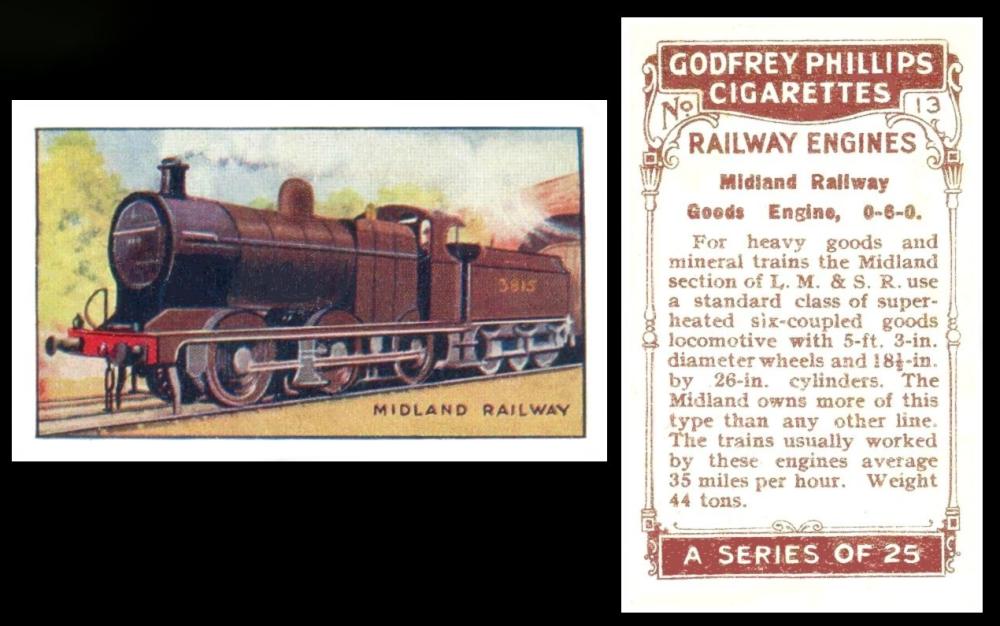
Godfrey Phillips [tobacco : UK] "Railway Engines" (1924) 13/25 - P521-360 : P50-77 : Ph.177 (RB.13/177)
Today, in 1841, a man arranged an excursion, a twelve mile railway trip on the newly extended Midland Counties Line, from Leicester to Loughborough, in order to attend a temperance meeting. The travellers, almost five hundred of them, paid a shilling, and everything was included. It went well, though the income only equalled the expenditure - and Thomas Cook was suddenly in the travel business.
His first travel bureau was on Fleet Street in London, it opened in 1865 and included a section which sold travel goods and books. He had already started to issue a guide to places of interest and accommodation with each of his tours, something that we ought to pay homage to every time we look at a travel brochure, either as a printed magazine or online.
And in 1938 Donald White, Chief Uniformed Representative of Thomas Cook`s, appeared in Churchman`s "In Town Tonight" (48/50)
The reason for this card is that it is one of the few to just say Midland Railway on the front. The railway started in 1832, purely to take men to the coal pits and take coal away, and in 1844 several lines merged to form the Midland Railway Company, with headquarters in Derby, . However in 1921 the Railways Act was passed and all these wonderful little companies were reduced to just four - the Midland becoming part of the LMS, or London, Midland and Scottish Railway
The set first appears in our original Godfrey Phillips reference book, RB.13, issued in 1949, where it is described as :
177. RAILWAY ENGINES. Small cards, size 64 x 28 m/m. Fronts printed by letterpress in colour. Backs in brown, with descriptive text. Issued 1924.
The text in our World Tobacco Issues Index is a bit shorter, just "RAILWAY ENGINES. Sm. 63 x 38. Nd. (25)
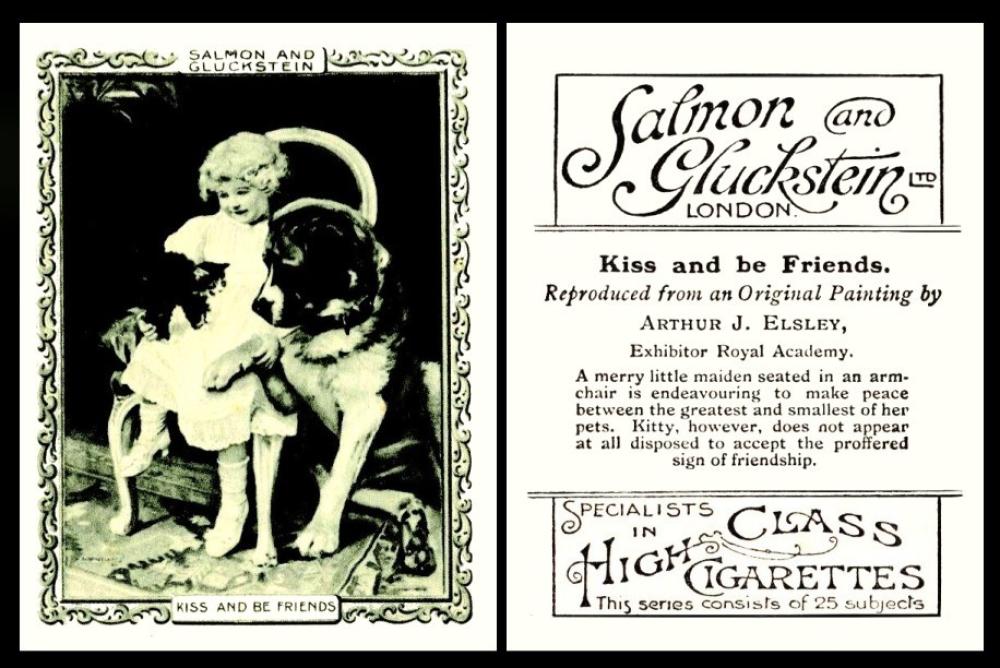
Salmon & Gluckstein [tobacco : UK] "Famous Pictures" untitled (1912) - S041-125.2 : S16-5.2
Here, for International Kissing Day, we have a little girl trying to make her cat and dog be friends. I am not sure that the picture suits the title, and also that a cat would ever actually kiss a dog, but never mind, it is a very sweet little image.
The actual painting is in full colour, as you can see online via Alamy/AJE so it is rather odd that it is only reproduced in green here. There was another series before this, which is all different paintings, but rendered in brown.
The artist, Arthur J, or John, Elsley, was born in London in 1860, and he painted throughout the Victorian and Edwardian eras, specialising in animals, especially children and pets. He died in 1952 in Tunbridge Wells.
Our original World Tobacco Issues Index records the sets as :
FAMOUS PICTURES (A) Lg. 76 x 57-58. Unnd.
1. Brown gravures (25) see H.386
2. Green gravures (25) see H.387
The Handbook references take you to a list of the cards that make up each set. And on hindsight I suppose that having the different colours were a good way of telling the two apart, though I still say they did nothing for the paintings that were shown.
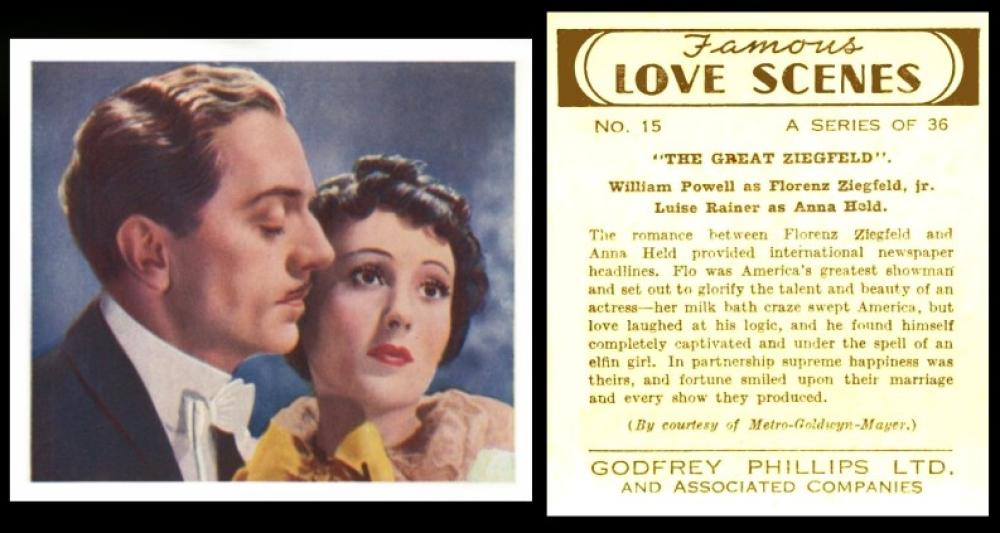
Godfrey Phillips [tobacco : UK] "Famous Love Scenes" (19394) 15/36 - P521-436 : P50-104 : Ph.67 (RB.13/67)
And to close, today in 1907, at the Jardin de Paris on Broadway, a musical review was staged for the very first time. The writer, and producer, was F. Ziegfeld Junior, and he had created an entertainment as a series of different "sketches", though some of them were very similar to parts of another musical on Broadway called The Paris Model.
For its time, it was groundbreaking, for it crossed the genres of music and comedy and drama. And it was such a hit that versions of what would come to be known as The Ziegfeld Follies, were playing for decades.
Florenz Ziegfeld had been born in 1867 in Chicago Illinois, and had his first big theatrical success with his father`s nightclub, which was opened to take advantage of the fact that the 1893 World`s Fair was not open all night though many revellers wanted it to. One of his first stars was the strongman and bodybuilder Eugen Sandow.
This scene is from a biography starring William Powell and Luise Rainer as his first wife Anna Held, who he had met in 1896, and who had starred in The Paris Model. The two look happy here, but in 1913, you will often read that they had been divorced. In fact, she had divorced him, rather scandalously for the time, and even more so because he was involved with one of his Ziegfeld girls, Lillian Lorraine. Or so it was said, because Anna Held was never Mrs. Ziegfeld by law, they simply co-habited, and had done so for so long that everyone believed they were man and wife. After "the divorce" everyone expected him to marry Miss Lorraine, especially as she had, for some time, lived in the same house as him and his wife, but he did not, he married actress Billie Burke, in 1914, though he still kept company with Miss Lorraine, and many others.
He died in 1932, leaving Billie Burke with huge debts, so much so that she had to return to acting in order to survive. She also continued to keep his name in the public eye and in 1936 the film on our card was released, with no small thanks to her efforts. In fact she personally chose William Powell to play The Great Ziegfeld. The film was nominated for seven Academy Awards and won Best Picture and Best Actress though William Powell lost out.
This set appears in our original Godfrey Phillips reference book, RB.13, issued in 1949, with this description :
67. 50 FAMOUS LOVE SCENES. Medium cards, size 61 x 53 m/m. Fronts printed by letterpress in colour. Backs in brown, with descriptive text. Issued 1939.
Our World Tobacco Issues Index shortens this, considerably, to "FAMOUS LOVE SCENES. Md. Nd. (36)"
And this is the same as appears in our updated version, except that the code is new.
This week's Cards of the Day...
have been looking at The Treaty of Versailles, which was the agreement that marked the end of the First World War, and, hopefully, peace, after which there would never be another war.
And this treaty was signed on the 28th of June 1919, five years to the day, exactly, that Archduke Franz Ferdinand had been assassinated, the spark which ignited to form the First World War.
Saturday, 24th June 2023
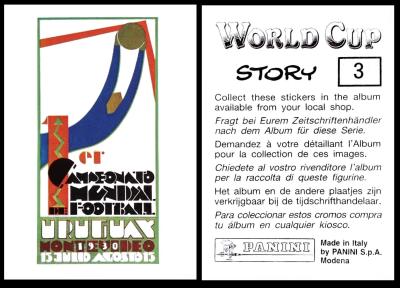
This is the poster for the first World Cup, held in 1930 in Uruguay, and they, believe or not, had a representative who signed the Treaty of Versailles. Other Central and South American countries did too, check out the actual document at The Keepers Gallery.
Now you may be wondering why, for they did not fight and were not invaded. And the answer is that they had supported the allies by breaking off diplomatic relations with Germany.
But, even more curiously, Brazil did actually go further, and declare war on Germany, in 1917, and before the United States of America.
If we look at the story of the World Cup, while we are here, it was due to take place in 1914, but was postponed because of the First World War, and did not take place until 1920. And Jules Rimet, whose cup this is, had been in the French Army, and had won the Croix de Guerre - though I have not tracked down why. And there is also the quite amazing coincidence that the first World Cup after the First World War, in 1930, was held in Uruguay and won by their national team - and the first World Cup after the Second World War, in 1950, was not held in Uruguay, but again they won it.
Now this card was almost removed, because as I was going through the index I found I had used this set "Panini World Cup Story" - before, to illustrate Ricardo Villa and his beard. But the back on that turned out to be different when I looked, it had a "SONRICS" logo. And it turns out that today`s card is not a double after all, but a different printing, issued in Colombia, so both will remain. And you can see that other card at https://csgb.co.uk/cardoftheday/2022-11-26
As for why this one, without the "SONRICS", is different, well it was issued the same year, 1994, but in Colombia. It also has another difference, because the number of stickers has been expanded to add in the 1994 World Cup finalists, who were Italy and Brazil.
Sunday, 25th June 2023

So here was clue number two to this week`s theme, the Palace of Versailles, where the treaty was actually signed, within the Hall of Mirrors. It seems very odd that the last card in this series, designed to show the beauties that the war was destroying, should be the site of the last act of the First World War.
The Armistice, or ceasefire, had come into effect on the eleventh hour of the eleventh day of the eleventh month in 1918, but it was not an end to the war, and also it only lasted for thirty-six days, after which it had to be renewed, something that had been done four times by the time that the terms of the peace had been thrashed out in meetings which Germany were not allowed to attend.
This set appears first in our Wills reference book part 3, where the description is :
71. 50 GEMS OF FRENCH ARCHITECTURE. Fronts lithographed in colour; backs in grey, with descriptive text. Two grades of board
a) white, glossy
b) cream, matt
Home issue 1917.
This is reduced to simply "GEMS OF FRENCH ARCHITECTURE. Sm. Nd. (50)" in both our original and updated World Tobacco Issues Indexes.
Now some collectors see this set and think it is just architecture. But it is really a set with a secret, because, yes, look at the fronts and it is a classical building of great historical importance and beauty. However if you look at the date, right towards the end of The First World War, you suddenly realise that this set was propaganda. Look, the cards say, this beautiful building, but is it still, amidst the war and the destruction that rages over France?
There were other "Gems Of" sets just like this, the first one issued being "Gems of Belgian Architecture", issued in August 1915, then there was a fairly substantial gap before "Gems of Russian Architecture" in February 1917, and our set followed fairly quickly along in the November of that year.
Remember that gap? Well, it baffled quite a few people, until the truth emerged in The Cartophilic World magazine, Volume 13, No. 150 - November/December 1960. And this is what was revealed :
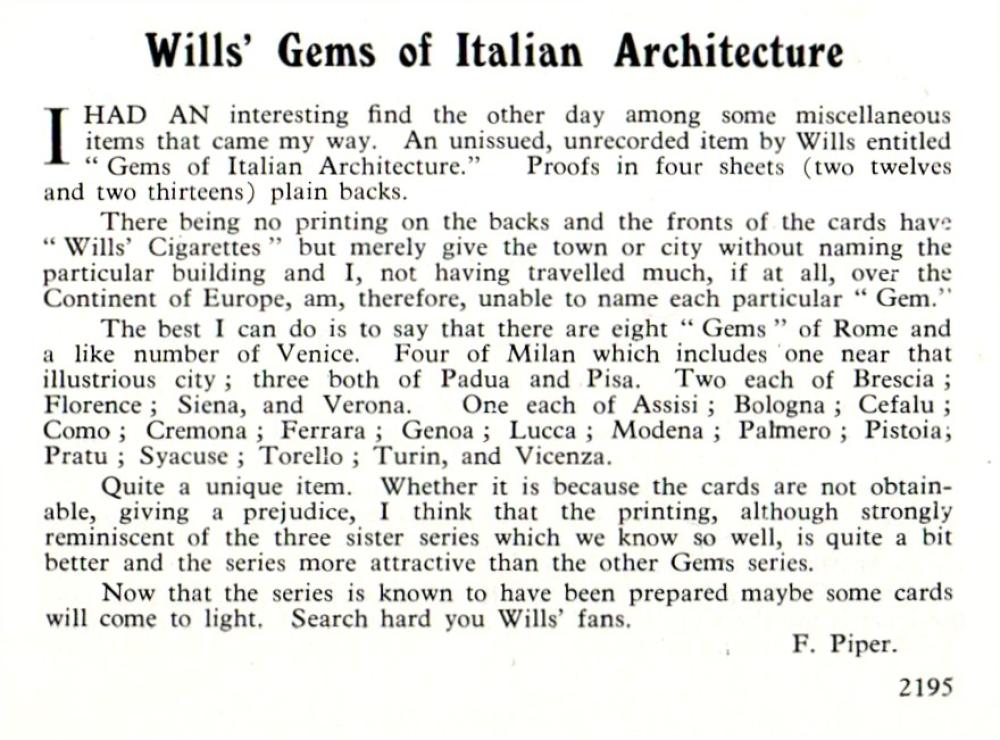
This means that it was never recorded in our original Wills Reference Books, nor our original World Tobacco Issues Index. However you will find it listed when the five Wills books were reprinted as a single hard back volume, because Wills did record that this set was due to be issued second in line, some time in 1916, which would have filled that gap.
We do not know why it was never issued, nor whether there was a text prepared but never printed. It seems even more curious that it was not issued and yet two other sets in the same series were. I can only suspect that maybe there was something about the Italian campaign that got this set shelved?
And the obvious question is where now is that proof set, that Mr. Fred Piper discovered?
Monday, 26th June 2023
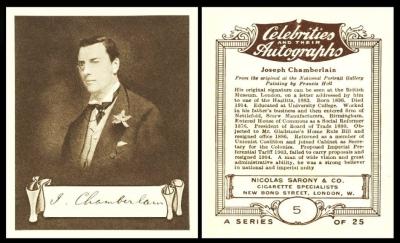
Now this simply stood for the autograph, or signature, on the document. And in fact there were sixty-six such signatures, representing thirty two different countries. The terms of the treaty required that Germany paid for the damage the war had caused, that it was no longer to own weapons, and that it had to give territories to other nations, worldwide.
However this autograph is rather special, for it is Joseph Chamberlain, the father of Prime Minister Neville Chamberlain, the man who had to announce the start of the Second World War in 1939.
Some say that this was the first set to have "autographs" in the title, but they are forgetting that Taddy issued a set with that name some years earlier in 1910. Strangely, then, that the Taddy cards are in full colour, whilst these are simply brown gravures.
Our original World Tobacco Issues Index tells us that this is a set of many permutations, which I like as it does give me lots of scope for future cards of the day as well as to replace any doubles that I come across as I work backwards through the index. The listing is :
CELEBRITIES AND THEIR AUTOGRAPHS. Small 70-72 x 41-43. Large 78 x 63. Brown gravures.
1. Nos. 1/25 (25)
Size (A) small (B Large2. No`s 26/50 (25)
(A) Small size, back with numerals (a) 2mm (b) 2 1/2 mm high
(B) Large size, back with numerals (a) 2 1/2 mm (b) 3 mm high3. Nos. 51/75 (25)
Size (A) small (B) large4. Nos. 76-100 (25)
Size (A) small (B) large
This information is repeated in the updated World Tobacco Issues Index but there is a curious omission in that all the 2 1/2s read 2_
Tuesday, 27th June 2023
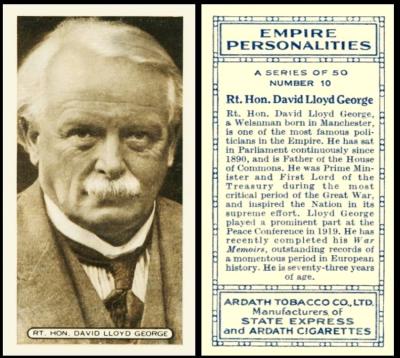
So here we have David Lloyd George, our Prime Minister at the time of the Treaty of Versailles. Though he was there simply to represent us, he also played much of a part in trying to calm things down, for France, under Georges Clemenceau, was very much against the Germans, and America, spearheaded by Woodrow Wilson was rather too easily swayed, so as not to be seen as being on the offensive.
Whilst, naturally, those who had been directly affected by the war very much felt the same way as France Lloyd George was a clever man and he knew that Germany could well have a vital role to play should the recent Russian Revolution come alive again and start to spread towards us. And if Germany was demoralised by the terms of the Treaty of Versailles, they would possibly seek to get us back by either allowing the Bolsheviks quick and easy passage through their country, or even by joining in with the fight, and turning it against us.
This set first appears in our Ardath Reference Book RB.6 but there is no code, because at that time the cards were simply listed in order not given a number order. In fact in several of my early RBs a previous owner, way less numerically challenged than I, has actually added the numbers in pen. Perhaps others did too, and this suggested that numbering the sets in future might be a useful practise.
The write up in that book is :
April 1937. 50 EMPIRE PERSONALITIES (titled series). Size 1 7/16 x 2 11/16. Numbered 1-50. Printed in two colours from half-tone blocks and varnished, titled, white margins. Backs, printed in bronze blue, adhesive, with description. Issued with State Express and Ardath Cigarettes. Also issued in Jersey.
Now as you might imagine this was shortened for the World Tobacco Issues Indexes, to simply : "EMPIRE PERSONALITIES. Sm. Nd. (50).
I do wonder why this set being very much relevant even down to the title, was not exported to other countries - for it included, amongst others, Stanley Melbourne Bruce (Prime Minister of Australia), Rt. Hon Michael Joseph Savage (the first Labour Prime Minister of New Zealand) H.E.H. Asaf Jah (Nizam of Hyderabad), and Mohammed Shah (the Aga Khan). And another inclusion, which literary lovers may not realise, is John Buchan, author of the Thirty Nine Steps but showing here as John Buchan, 1st Baron Tweedsmuir, Governor General of Canada
Wednesday, 28th June 2023
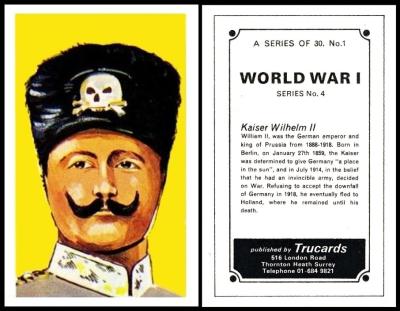
Here we have the German Kaiser at the time that the Treaty of Versailles was signed at the Hall of Mirrors,.
However there is another reason he is here as well, for his grandfather, Kaiser Wilhelm I, was formally proclaimed as emperor of Germany and Prussia in that same Hall of Mirrors on the 18th of January 1871. And that was a hundred and seventy years, to the day, that Frederick I was made the first ever King of Prussia in 1701.
This set, and all the Trucards issues, appear in our British Trade Index volume III. As this is their first appearance, we will list all here and link off from it. The full listing reads :
TRUCARDS, Thornton Heath, Surrey.
Cards Issued 1972
- Animals. 69 x 43. Nd. (30) ... TRWM-1
- Battle of Britain. 70 x 44. “Series No.6”. Nd. (30) ... TRWM-2
- Flowers. 68 x 43. Nd. (30) ... TRWM-3
- History of Aircraft. 69 x 45. “Series No.7”. Nd. (30) ... TRWM-4
- Sport. 69 x 43. Nd. (30) ... TRWM-5
- Veteran & Vintage Cars. 68 x 43. Nd. (30) ... TRWM-6
- World War I. 70 x 44. “Series No.4”. Nd. (30) ... TRWM-7
- World War II. 69 x 45. “Series No.5”. Nd. (30) ... TRWM-8
Now sadly this issuer does not appear in the updated British Trade Index, because the cards are commercial. That was one of the (sadly necessary) exclusions that was decided to keep the book small enough to handle.
They were also not reported in the New Issues sections of the Cartophilic Notes and News, I have checked all the 1972 issues.
We can add a few things from other sources though.
The back of the card gives an address for Trucards, 516 London Road Thornton Heath Surrey. That is currently up for sale, and is quoted as being retail and industrial use, though there is planning permission for it to becme a unit and residential flats.
The Murray Catalogue of Values agrees that all were issued in 1972, but gives the size as medium. That is not easily picked up if you do not see the card. They cite the most valuable set as “Battle of Britain”, the cheapest as “Animals” and “World War II”.
We also know that there are two formats, a photographic one and an art drawn one.
The photographic sets ("Animals", "Flowers", "Sport", and "Veteran and Vintage Cars" all say on the backs that they are “From a Natural Colour Photograph by George Austin`s Colour Library International Ltd. New Malden Surrey England”.
The art drawn ones ("Battle of Britain", "History of Aircraft", "World War I" and World War II") do not say this, but they are also the ones that bear a series number, so we know that they were the second batch to be issued. Perhaps they found someone in-house to draw those, and stopped paying Mr. Austin? It is also curious that all of these sets are military related.
Another oddity is that if you look at the series numbering there is an anomaly. There are four sets from George Austin`s Colour Library, but the art drawn sets start with "World War I - Series No.4”, and then continue with "World War II - No.5”, "Battle of Britain - No.6”. and "History of Aircraft - No.7”. I cannot believe that they went back to George Austin so they must have just got the number wrong for the World War I set?
Thursday, 29th June 2023
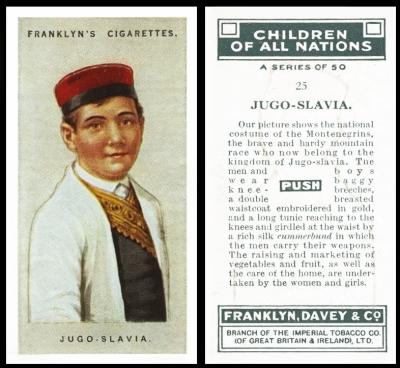
Now this is a very pertinent card for this week because this little man`s life was directly influenced by the Treaty of Versailles. He looks about eight, so in his lifetime already he had probably lived in Montenegro, then in the Land of the South Slavs, then, from 1918, in the Kingdom of Serbs, Croats and Slovenes, and then, finally, in Jugo-Slavia as it says on this card. However there is a bit of a problem here, because by the time this version of this card was issued in 1934, he was living in the Kingdom of Yugoslavia, created in October 1929. Not sure why Franklyn Davey did not change this, and also I have to wonder whether any other boundaries had shifted, making other cards not exactly correct.
The Treaty of Versailles did not make these changes, though it did, very importantly, recognise The Serbo-Croat-Slovene Kingdom by adding its name to the signatories. Unfortunately others were not so happy, most notably Italy, who firmly believed that part of that area should have been given to them for helping us in the First World War. There are also rumours that the Allies did indeed promise this to the Italians, and that documents were even signed to that effect, but then they reneged and gave it elsewhere. Some even say this this is why Italy fought for us in the First World War, but fought against us, teaming up with the similarly aggrieved Germany, in the Second World War.
This charming set first appears in our original World Tobacco Issues Index, with this brief description : "CHILDREN OF ALL NATIONS. Sm. Nd. (50). Cut-outs. See RB.21/200-168.E" And that is repeated, but with a new code, in our updated version.
However RB.21, being our British American Tobacco Company reference booklet, is always proof of export versions, and often more than one, and here we are amply rewarded, with
RB.21/200-168. CHILDREN OF ALL NATIONS. Series recorded in W/168 and RB.15/58. All the printings of the series are summarised below :
A. Wills` Overseas issue.
B. I.T.C. of Canada issue, inscribed "7718"
C. U.T.C. issue.
D. Ogden Home Issue
E. Franklyn Davey Home Issue.Printings A-C are B.A.T. issues, printings D-E are I.T.C. issues. Printings A, D, and E are cut-outs.
Quickly comparing of these issues in other books allow us to add that
A - W.D. & H.O. Wills - text is slightly different in our World Tobacco Indexes, being - "Sm. Subjects die-cut to stand out. Nd. (50) See RB.21/200-168.A". However there is a much fuller description in our original Wills reference book (part IV), namely : "Fronts printed by letterpress in colour. Subjects cut and perforated to stand out. Backs in grey with descriptive text. Issued in New Zealand, between 1925-30. Similar series issued by Franklyn Davey, Imperial Tobacco Co of Canada, Ogden, and United Tobacco Co. (South Africa)" The actual date of issue of this version, according to Wills own records, was March 1925
B - Imperial Tobacco Company of Canada, Ltd - quite a few differences here, the full text being "Sm. 68 x 36. Nd. (50). Serial 7718. See RB.21/200-168B. Ref. USA/6. This version was issued in 1924.
C - United Tobacco Companies (South), Ltd., South Africa - our original World Tobacco Issues Index has a text of "Sm. Nd. (50). See RB.21/200-168.C", this does not include the word "Cut-outs". In the updated version it adds "67 x 36." after the "Sm." and before the "Nd." This version was issued in 1928
D - Ogden`s - RB.15/58 tells us very much the same as the Wills description above : "Fronts printed by letterpress in colour. Subjects cut and perforated to stand out. Backs in green with descriptive text. Home issue, 1924. Similar series issued by Franklyn Davey, Imperial Tobacco Co of Canada, Wills, and United Tobacco Co. (South Africa)". Our original World Tobacco Issues Index simply says "Sm. Nd. (50). Cut-outs. See RB.21/200-168.D" However our updated version adds that "uncut cards are known". This version was issued in 1924
Friday, 30th June 2023
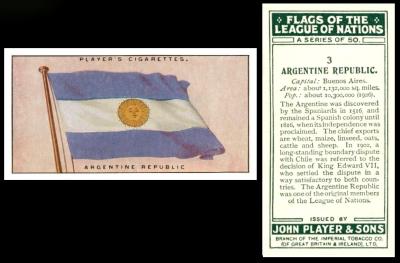
Now though Argentina did not sign the Treaty of Versailles they are there in an annex as one of the states invited to sign at a later date. And they were part of the League of Nations which followed; in fact they joined that on the 10th of January 1920, though they withdrew in 1921 as a protest to one of their resolutions being rejected, and only returned in September 1933.
Actually whilst researching this I found that the Kingdom of Serbs, Croats, and Slovenes also left the League of Nations at some point, but I am having a spot of bother tracing that.
The League of Nations remained throughout the Second World War, and was only dissolved on April 19, 1946. Though dissolved is too gentle a word, for its end was rather shocking, and it came in Geneva, when one of the original men involved with setting it up, Viscount Robert Cecil, gave a brief description of how it had done, and then ended with the exceptionally brutal statement - "The League is dead. Long live the United Nations."
This set is more optimistic, and in 1929 it must have seemed that it would fulfil its purpose of stopping another war. It appears in our original John Player reference book, RB.17, issued in 1950, as
97. 50 FLAGS OF THE LEAGUE OF NATIONS. Small cards. Fronts in colour. Backs in grey, with descriptive text. Home issue, March, 1928.
Colour variety : No.7 - Background of flag (a) dark blue (b) purple
This is again very much shortened in our World Tobacco Issues Indexes, to merely "FLAGS OF THE LEAGUE OF NATIONS. Sm. Nd. (50).
However, it is rather exciting to me that the code in the original World Tobacco Issues Index is 97, exactly the same suffix as in the original John Player reference book - for I cannot remember noticing that before.
thanks for your patience, and see you all next week!
